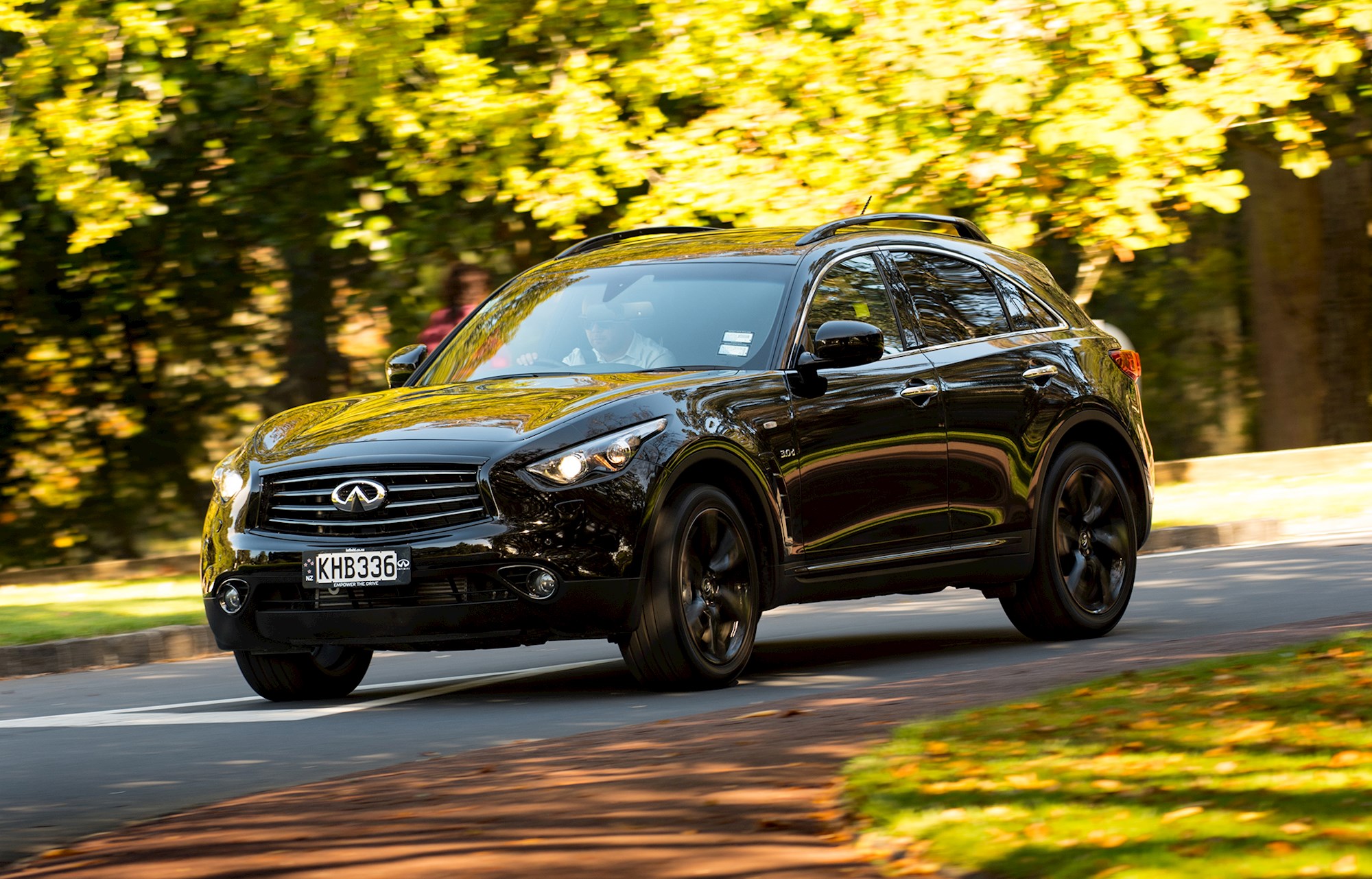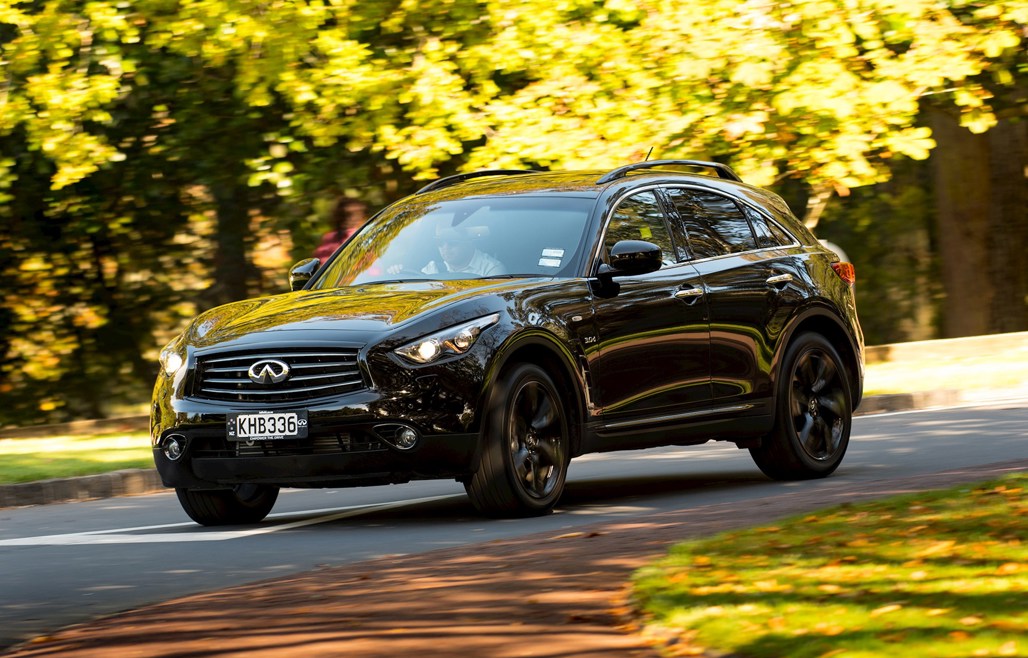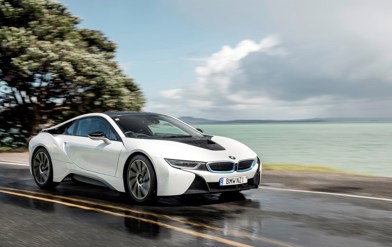Globalisation, corporations, big city fat cats wearing bow ties and bowler hats snorting caviar from table tops at the Bellagio.
Hollywood's cartoonish interpretation of modern-day business is wide of the mark in many ways. More often than not the reality of those living these lives is an endless stream of meetings balanced out by endless drinking.
And at some point in the transaction a deal is done, and out the other end comes a brand like Infiniti.

Infiniti are a manufacturer relatively new to the New Zealand market, but they're intriguing in multiple ways. Think of them as Nissan's luxury arm — much like what Lexus represents to Toyota.
While they've been an ambitious force in other markets for as many as three decades in some cases, Infiniti only joined the New Zealand landscape last year. And these are two of their SUVs; the compact QX30 and the mid-size QX70 (the former pictured in white and the latter in black, respectively).
Both are sharp, unique lookers. Both are packed with luxury tropes. And both claim to fulfil the same brief of tackling a Europe-centric opposition head on.
Yet, you would be hard pressed to find two more different vehicles in the segment.

Take engines for example. Our S Design–spec QX70 came equipped with a 3.0-litre turbo-diesel V6, developing 175kW and 550Nm. On start-up and idle its quiet, almost sounding more like a petrol-fuelled unit. Off the mark it has to navigate a thick layer of turbo lag, but once that's dealt with it's capable of throwing the large SUV down the road at an alarming rate of knots.
It manages to be gruff and powerful, while also feeling surprisingly refined. And it rarely comes across strained thanks to a power band that delivers all of its torque well before red-line.
Then you have the AWD GT–spec QX30. It's powered by a smaller 2.0-litre turbocharged inline four petrol, making 155kW and 350Nm. A more humble set of figures, sure, but it makes up for it with how eager it is. Generous applications with the right foot are met with a manic urgency. It likes to rev (though some of the noise is artificial), and a much sharper dual-clutch transmission makes it the much more refined and predictable powertrain package.

And it's a similar tale of difference inside, too. Both cars come with superb Bose sound systems, but everything else is night and day. The QX30's design is modern and full of sweeping lines, while the QX70 looks and feels at least 10 years old.
And that's because it is. There's more to the story here, with both of these cars.
Business and globalisation in motoring tends to manifest itself best through 'badge engineering'. This is when car-makers re-badge certain vehicles as different things for different markets. It can come in the form of a simple badge swap, or in the form of something much more comprehensive.

Though the QX70 is new to New Zealand, it was first launched in this guise back in 2008. Underneath, it shares the 'Nissan FM' platform with a raft of vehicles including the Nissan Skyline and even the 370Z sports car.
The QX30 on the other hand is essentially a Mercedes-Benz GLA with a Japanese twist. It shares the same platform and manufacturing 'hard points' as the Merc, as well as plenty of its switch-gear, its engine, and transmission. Even the key is from Mercedes.
A confusing mix to be sure, but one that made more sense when Mercedes-Benz revealed their Nissan Navara–based X-Class ute last year — they’re two manufacturers with an engineering relationship that's clearly flourishing.

The sports-car derived rear-wheel drive platform under the QX70 naturally makes it a total joy to drive; particularly in sport mode. Body-roll is negligible, and its steering is among the most direct in this class.
Many newly launched SUVs boast about their cornering capabilities, but few would be able to hold a candle to the big-70 for sheer driving pleasure. And that's not too surprising, given that in some ways it helped pioneer the performance-luxury SUV genre.
There are other positives for the QX70, like soft-touch interior materials that extend all the way to the floor and a packed features list that includes a 360-degree camera, adaptive headlights, heated and cooled front seats, Infiniti's comprehensive 'Safety Shield suite, and plush quilted leather punctuated by purple stitching. But most of those positives are mired by a cabin that's clearly been around the block a few times.

Ultimately it's an SUV from the old world; due for a replacement — perhaps in the form of the new QX60 7-seater set to soon debut in other markets. And with pricing starting at $99,990 going up to $114,990 for our premium S Design test car, the QX70 is very much a niche choice.
The QX30, however, is a much more relevant proposition.
With more sensible raised-hatchback dimensions and pricing the QX30 feels a better fit for today’s SUV market. Our 2.0-litre AWD GT test car weighed in at $61,990 (just $1000 more than the piddly 1.6-litre Mercedes-Benz GLA 180), while the range-topping Sports Premium variant is $71,990.

It too comes equipped with the Infiniti Safety Shield suite, which includes forward collision warning and emergency braking, traffic sign recognition, and rear parking sensors. Only the top Sports Premium gets blind-spot monitoring, adaptive cruise control, and lane-departure warning.
Space in the front is fine and boot space is an impressive 430 litres, but both come at the expense of rear legroom. And if you want more luxury, like heated and electric seats or leather upholstery, again you’re going to also have to opt for the Sports Premium model.
Key interior grimaces include a large amount of dust and fingerprint–attracting piano black plastic, and the lack of Android Auto or Apple CarPlay. There's also ergonomic shortcomings, like the infotainment dial that the wallet in my pocket would nudge with every right-hand turn. The rest of the controls are largely simple to use, though it is a touch grating to see so many blanked-off buttons in obvious locations.
It’s not as engaging to drive as the QX70, but it doesn’t need to be. This is a comfort-first vehicle, and it sticks to the brief superbly. Noise cancellation is impressive and steering is light and accurate, which makes this a very easy crossover to live with.

The question at the end of it all is whether it’s worth going with this instead of its Mercedes-Benz equivalent.
And that’s up to you. One of them comes headed with a three-pointed star and all of the supporting cache, while the other looks genuinely unique and distinctive with a cheaper buy-in for a 2.0-litre option.
Infiniti’s current presence is small, but they’re a brand with big ideas and a desire to muscle (and in some cases work with ... ) the best in the business.
Watch this space, because they might surprise you.
2017 Infiniti QX70 3.0 S Design
Price: $114,990
Pros: Lovely handling, build quality and equipment, exterior looks have aged well
Cons: Interior looks have not, lack of NZ GPS from factory, pricey
2018 Infiniti QX30 2.0T AWD GT
Price: $61,990
Pros: More distinctive than its German cousin, peppy powertrain, comfort
Cons: Interior ergonomics, blank buttons, Sports Premium model the better bet


























